Friday, April 10, 2009
Unbranding?
In Mavericks at Work Jim Buckmaster, CEO of Craigslist, revels in what he calls the "unbranding" of the site. At first glance, CraigsList.org doesn't have the trappings of a hot brand. No logo, no real web design, no color scheme. But a brand is much more than a logo and pretty design elements.
I completely disagree with Buckmaster's assessment that CL doesn't have a brand. Their brand is huge, and the "unbrandedness" of it is a big part of what makes it so.
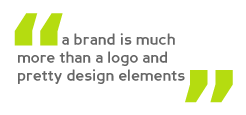 In it's more basic essence, a brand is the story your customers hear and the way they feel every time they interact in any way with your company. It includes the obvious visual elements - colors, logos, typography, packaging - as well as some not-so-obvious elements. For instance, the tone and choice of words in a headline is branding. The personality of your wait staff is branding, as well as is everything on your menu. Your product is your brand, and so is the customer service section of your website.
In it's more basic essence, a brand is the story your customers hear and the way they feel every time they interact in any way with your company. It includes the obvious visual elements - colors, logos, typography, packaging - as well as some not-so-obvious elements. For instance, the tone and choice of words in a headline is branding. The personality of your wait staff is branding, as well as is everything on your menu. Your product is your brand, and so is the customer service section of your website.
CraigsList has a brand because everyone knows and buys in to what the site is about. Seth Godin would say that they have a tribe.
Even if you haven't gone through a formal branding process for your company, you have a brand. There's a general understanding that your customers and vendors have about you. If you just leave it at that, you won't really capitalize on it's power. Here are 4 steps to making your brand a powerful tool.
- Define your brand. Sit down with customers, vendors and employees and ask "What are we all about". Dig deep to find the common, underlying themes. Do a SWOT (Strength, Opportunities, Weaknesses, Threats) analysis. The key here is complete honesty. There's no room here for Dilbert-esque mission statements.
- Define your audience. Go beyond simple demographics (i.e. males 30 - 50) and seek to truly understand who you want to talk to and who wants to listen.
- Take all the data from the above exercises and find 3-5 (ish) bullet point statements that can become the core of your brand message.
- Include the above brand message points in every interaction with customers, vendors and employees. Every sign, sales letter and website should focus on those points. Write an elevator speech including them. Take one and make it a focal point for advertising.
Keep this tool sharp by focusing on it as a regular part of your business practices.
Wednesday, April 8, 2009
8 graphic design tips for non-designers
Many small & medium-sized businesses create their marketing materials in house without the benefit of being able to use a trained graphic designer. With so many tools available these days, it been easy for any business person to start creating business cards, websites and simple brochures on their own.With that in mind, here are 8 principals to making your projects visually stand out in the crowd.
- Try a distinctive illustration style instead of standard stock photos. How many smiling customer service portraits have you seen this week? You probably can't remember, because you ignored them. One way to get instant attention is to go away from the kind of stock photography you see everywhere. iStockPhoto.com has an HUGE selection of inexpensive royalty-free illustration you can use to spice up your visuals.

- Use a metaphoric image instead of realistic one. Take that smiling customer service shot I mentioned previously. You want to tell your viewers about how well you'll take care of them. Finding a metaphor will increase how the idea resonates in their minds. Remember Staple's "Easy Button"? Play word association with co-workers or friends to come up with ideas.


- Use lots of white space. The temptation is to fill every inch of available space with something. Unfortunately, many times that actually decreases the effectiveness of your content. "White space" is used to help direct the eye to the important parts of your message, helping viewers parse the information and retain it.
- Stick to one message, and say it loud. This is related to the last. Break down your marketing into simple core messages, then follow the "one-per" rule. One thought per brochure page, per flyer, per slide. Directing the focus of your audience to one point will maximize recall.
- Play with scale. Changing the size of objects and text on the page increases the visual excitement and helps direct the eye. It's also a great way to separate yourself from the pack visually. Showing something way bigger that it really is catches attention. So does something very small surrounded by lots of big things.
- Contrast. The more contrast in your piece, the more it will be noticed. Contrast size and scale, when everything is the same size it's hard to differentiate what's important. Use contrasting colors to draw the eye to different areas of the layout.
- Work an interesting color scheme. Color is one of the most powerful tools in your toolbox. Humans have huge psychological reactions to colors, so use that to your advantage. It's really easy to get into a simple, primary color palette that blends in with everything else out there. Take a visit to Adobe's Kuler.com website and explore some of the incredible color schemes there. A unique mix of colors will grab attention immediately!

- Stick to two fonts and a few styles. Mixing typefaces is an art, one that requires time and experience. When you are designing something, choose an interesting or bold font for the headline and subheads and another for the body text, and stick to just those. Avoid overuse of bolds, italics and different colors within the main body of the copy. All of this makes it easier to read and comprehend your text.
Friday, March 27, 2009
What's up with that?
I love observational stand-up comedy. Jerry Seinfeld and Ellen Degeneress are masters of finding tiny moments of life and turing them into belly laughs. What's interesting to me, is that those jokes are spun from really small slices of daily life. They must spend a lot more mental energy than most observing and analyzing life.Think about this in the context of branding for a moment. Branding is the sum of all the interactions your customers and vendors have with your company. What if you could take those little things, that everyone else takes for granted, and turn them into something wonderful. Spend a day looking at your company like you were Jerry or Ellen. What would they see and turn into an 8-minute hilarious story.
It's amazing how little sparks of awesomeness have a way of staying with customers for a long time. It's easier to win the game by consistently hitting a ton of singles and doubles than by hoping for a home run each time you're at bat.
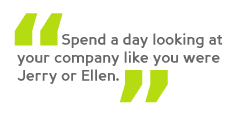 CDBaby elevates the order confirmation e-mail to something brilliant. I ordered a CD seven or eight years ago, but I still remember getting the e-mail that it was shipping. Instead of saying "Your order has been shipped" they told me that they removed the CD from storage wearing white gloves and placed it on a velvet pillow to be carried to the shipping department accompanied by the cheers of the warehouse staff. It was four paragraphs of brilliant branding that I still smile about.
CDBaby elevates the order confirmation e-mail to something brilliant. I ordered a CD seven or eight years ago, but I still remember getting the e-mail that it was shipping. Instead of saying "Your order has been shipped" they told me that they removed the CD from storage wearing white gloves and placed it on a velvet pillow to be carried to the shipping department accompanied by the cheers of the warehouse staff. It was four paragraphs of brilliant branding that I still smile about.Has anyone caught the latest viral YouTube video featuring a Southwest flight attendant rapping the standard spiel that everyone ignores? When was the last time your were on a flight where passengers gave the attendants a round of applause?
Monday, March 9, 2009
Brainstorms
One of the keys to effective advertising is obviously creativity. Many assume (incorrectly) that creativity is something that you either have or you don't. The truth is that with the right environment and mind-set, anyone is capable of creative thinking. A common scene in the advertising world is the proverbial "brainstorming meeting" to kick off a new campaign. This the vital meeting where great, creative campaigns are born. It's also the birthplace of the all the mediocre and bad marketing ideas you've seen. Successful, creative brainstorming sessions are a combination of leadership, planning, and sometimes pizza.
This is my process for conducting a great brainstorming meeting:
- Solidly define the question. This sounds like a no-brainer, but I think many times it's glossed over and the results don't really hit the sweet spot. What are you really trying to figure out here? Take a minute and think it through, make sure that your group is going to head off the right direction from the start. Anyone who has read Douglas Adams' Hitchhiker's Guide to the Galaxy series know what I'm talking about. The answer is 42, right?!
- Set the stage. During the first part of a brainstorming session, there can be no editing or negative commenting on any ideas thrown around.
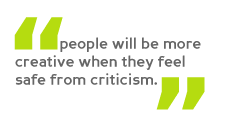 A fun idea is to give everyone a Nerf ball, and whenever someone makes a negative comment about an idea, the rest of the group throws the balls at them. THIS IS THE MOST IMPORTANT PART! Obviously not every idea that is said will be valid, but with the right environment those ideas will trigger other ideas, and people will be more creative when they feel safe from criticism.
A fun idea is to give everyone a Nerf ball, and whenever someone makes a negative comment about an idea, the rest of the group throws the balls at them. THIS IS THE MOST IMPORTANT PART! Obviously not every idea that is said will be valid, but with the right environment those ideas will trigger other ideas, and people will be more creative when they feel safe from criticism. - Using a whiteboard or large post-its, write up each thing said. Using a mind-mapping approach might help, showing how ideas are related. It depends on what kind of people you have, though. Some people respond best to just random listings. There will be several lulls during this period. When you get to a lull, try implementing a triggering activity, like word-association, or asking to visualize a juxtaposition (i.e.-what would this product be like if it was a military persona). Sometimes, I'll throw out an obviously outrageous idea, just to get a laugh and that will start people back thinking again. The goal of this phase is quantity not quality.
- Editing. After everyone is worn out & tired. Take a break, then go back to the ideas and begin to discuss the merits of each and edit. Go over combinations of ideas and push some further. There will be ones that everyone hates, have some fun when you cross them out. This is also the time for thinking about implementation and production issues.
Some things to keep in mind:
- Everyone needs to be comfortable. Board rooms are the worst environment for this activity. Go offsite if you need (sometimes this helps a lot!). Get good chairs or pillows, allow everyone to dress how they want and keep the room temp around 69.5 degrees. This also goes for the emotional environment. Make sure that everyone feels accepted and part of the group. Many people will not offer ideas because self-doubt and the fear of criticism creep in. When they can trust that they won't be made fun of, the ideas will come out.
- Food is always good. Fruits and nuts, crunchy things, jerky, cheese. Stay away from pastries and such. Some soda is OK. Water is good. And make sure it's quality food.
- The person driving needs to be "on". Keep things light and fun. Run around with energy & compliment ideas. Keeping the group energized and excited will produce more and better ideas. Another key thing is that you can't be the boss. Push the ideas, not the people.
Thursday, March 5, 2009
He said, she said
What do trust more, sales copy from a brochure or the recommendation of someone you know? Having well-written marketing copy goes a long way to making the sale. If you want to increase the power of what you've written, add a testimonial from a real customer to back it up. I personally do a lot of shopping online. Since I can't inspect the product I'm buying, I rely heavily on those ratings left by other customers. Amazon.com innovated the use of customer ratings for e-commerce, but using testimonials for marketing has been around forever.
The most effective customer testimonials always follow a similar pattern. First, they are usually about two to three sentences long. Simply saying "great product" isn't going to be very useful. Those sentences should be specific in the real benefits your product or service gave the customer. 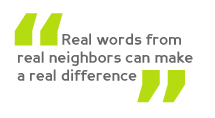 The more focused on results, the more the reader will be inclined to use that information in their buying decision. Another way to make an endorsement more convincing is the use the full name and position of the person quoted. This is important regardless of the name recognition factor. You can get mileage out of a testimonial from someone who is prominent in the field, but people identify with those who have similar needs. Glowing praise from "Becky Nelson, mother of 3 in Jacksonville" will have a much more impact then 'B.N.".
The more focused on results, the more the reader will be inclined to use that information in their buying decision. Another way to make an endorsement more convincing is the use the full name and position of the person quoted. This is important regardless of the name recognition factor. You can get mileage out of a testimonial from someone who is prominent in the field, but people identify with those who have similar needs. Glowing praise from "Becky Nelson, mother of 3 in Jacksonville" will have a much more impact then 'B.N.".
If you don't have stacks of letters extolling the virtues of your company, you can build a great bank of testimonials by just asking. Sending customer surveys is a quick and easy way to start. When crafting a survey, be sure to guide your customers in writing useful endorsements. Ask them about how they've benefited from your product or service, and get permission to use their name. You may have a client that is a well-respected figure in the community. Certainly adding their recommendation would be a benefit. In may cases, these are busy people. You can offer to write a testimonial as a basis for them to edit and embellish.
Even if you do give someone a writing prompt, the best testimonials have an authenticity that makes them powerful. People are very marketing savvy today, and can sniff a bogus sales pitch from a mile away. Real words from real neighbors can make a real difference.
Monday, March 2, 2009
Hide and Seek with Google
Search Engine Optimization (SEO) is a top priority for most businesses these days. There are approximately 3 zillion websites out there and your company needs to move up in the search results. Here are the basic things you can work on to begin to raise your page rank. Note that this is a process and you won't jump from #34,519 to #3 overnight.
Begin by working out exactly which keywords you want to be found by. Put yourself in the scenario of a potential customer who doesn't know much about your industry or company. What would they type in the search box? You may want to ask some of your actual cusomers how they found your site. Think about things like geography too. If your clients are mostly local, make sure that the name of your town is part of your keyword list. A good idea for retailers is to add the brand names you carry as well as the product category (for instance, use both "Whirlpool" and "oven"). The better you work this out now, the more potent your results will be.
Google looks at the HTML code and content of your pages and searches for keywords. Part of the page ranking system is how the words are used on the page. The first thing looked at are the URL and page title. Google gives a lot of weight to keywords that appear in those areas. 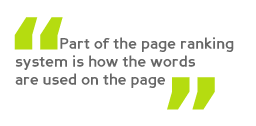 If your URL is www.oven-store.com and the page title is "Ovens by Whirlpool, Kenmore and GE", you're going to get high results for the word "oven". A lot of businesses have the company as the URL already. If this is that case, focus on the the page title.
If your URL is www.oven-store.com and the page title is "Ovens by Whirlpool, Kenmore and GE", you're going to get high results for the word "oven". A lot of businesses have the company as the URL already. If this is that case, focus on the the page title.
The next highest ranked area for a keyword is in headings, the <h1> HTML tag. These are the headlines on your site. Putting the right words in the headings jumps your page rank higher. Using the oven example again, a heading that reads "We sell top-brand ovens at great prices" is going to be rated higher than "Great prices and great service". Using subheads with the <h2> tag helps as well.
The search engine is then going to rank the rest of the content by the use of the keyword. Be careful not to artifically stuff your text with repeating words, as most search engines wil notice that and actually rank your page lower for cheating. This also makes for poor reading.
The previous paragraphs show the most important places for focus your SEO efforts. There are a number of other places that you can work in keywords that only have a small effect on your page rank. In the HTML of you page, using the <meta> tag for a page description and key word list is one. Using the <bold> tag helps a bit too. Images in HTML have an atrtibute called "alt" which provides a text description for the image. Using "alt" not only helps your SEO, but makes your website more accessible to those with disabilities.
Another part of the search formula is links. Site that have a lot of other sites using a particular keyword that link to it are considered more relevant and are ranked higher in the results. The process of building those backlinks to your site takes so time to do right. You can ask for reciprocal links with other sites, work with bloggers to have them link to your pages, and list your site in directories. If you are part of an online community, put your URL in your signature with a link. Avoid free-for-all link pages and "link farms" participating in those are considered cheating and at best, lower your page rank and at worst can get your site blacklisted from search engines. Publishing good, relevant content and a steady bit of elbow-grease in getting the word out naturally will go a long way.
Thursday, August 28, 2008
Great Logos
A walk down Main Street or 10 minutes of television 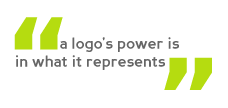 means we're going to encounter logos. A logo is the most obvious and consistent visual representation of a company's brand identity.
means we're going to encounter logos. A logo is the most obvious and consistent visual representation of a company's brand identity.
What is it that makes a great logo?
A great logo has a concept. Logos are symbols that are going to bring an emotional reaction to the person viewing them. When crafting a logo, whether a new one or updating an old one, focus on giving the symbol a conceptual meaning. An excellent example of this is Sprint's "pin-drop" icon. An early campaign boasted such a clear signal that one could hear a pin drop. That idea became a long running campaign. The visual of a pin dropping in their TV spots became the new logo.
Great logos are simple. In your mind, picture some of the most recognizable logos. Apple, Coke, McDonald's, Nike, CBS. All use a simple, clear icon with clean typography. Simplifying the image focuses the viewer on only the most important elements, thereby making what is seen more powerful.
Great logos are timeless Coca-Cola has used the same logo for decades. A logo should be free from trendy and fashionable design elements that can date it once those elements are no longer "in". This has been a issue now more than in the past as graphic designers have harnessed the power of computers and reproduction technology has advanced and changed. The temptation to use all of the available technological tricks in making a logo is strong, but ultimately the results won't last.
In the long run, though, a logo's power is in what it represents. A logo means something to a consumer because they use that symbol to associate an emotion and/or experience with the company. Building a strong brand, one that consistently brings an exceptional experience to the consumer, is the key. Great logos represent great experiences.


